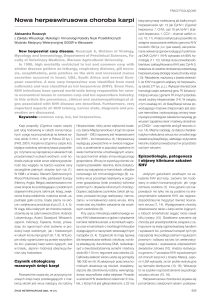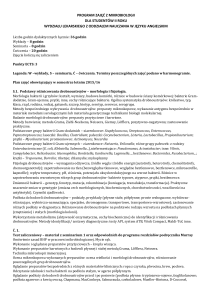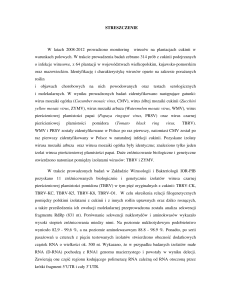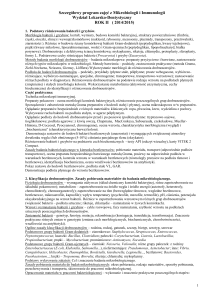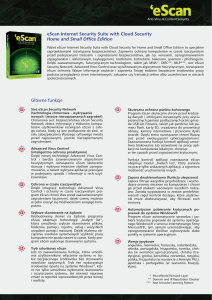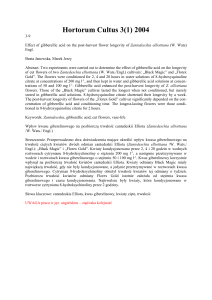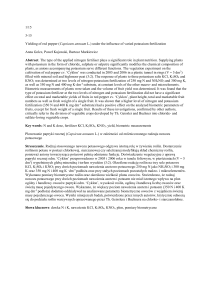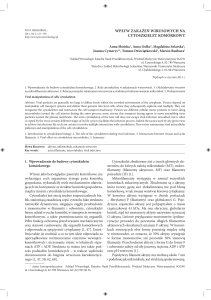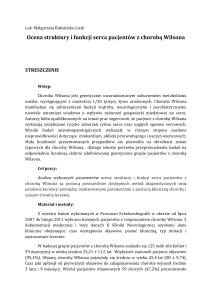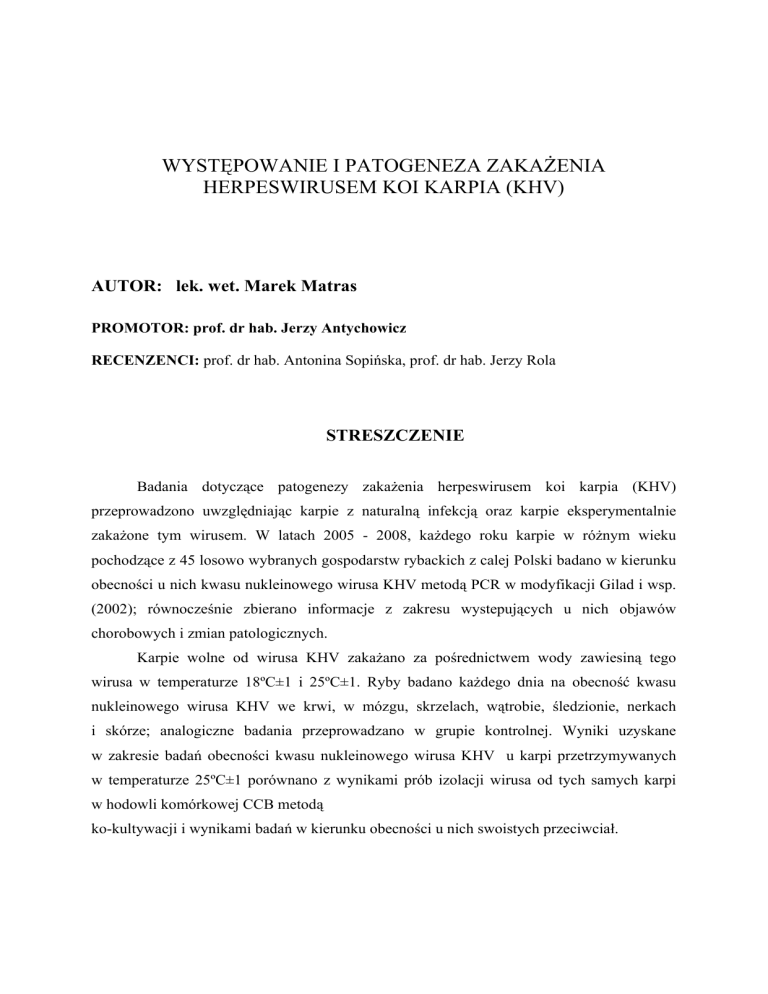
WYSTĘPOWANIE I PATOGENEZA ZAKAŻENIA
HERPESWIRUSEM KOI KARPIA (KHV)
AUTOR: lek. wet. Marek Matras
PROMOTOR: prof. dr hab. Jerzy Antychowicz
RECENZENCI: prof. dr hab. Antonina Sopińska, prof. dr hab. Jerzy Rola
STRESZCZENIE
Badania dotyczące patogenezy zakażenia herpeswirusem koi karpia (KHV)
przeprowadzono uwzględniając karpie z naturalną infekcją oraz karpie eksperymentalnie
zakażone tym wirusem. W latach 2005 - 2008, każdego roku karpie w różnym wieku
pochodzące z 45 losowo wybranych gospodarstw rybackich z calej Polski badano w kierunku
obecności u nich kwasu nukleinowego wirusa KHV metodą PCR w modyfikacji Gilad i wsp.
(2002); równocześnie zbierano informacje z zakresu wystepujących u nich objawów
chorobowych i zmian patologicznych.
Karpie wolne od wirusa KHV zakażano za pośrednictwem wody zawiesiną tego
wirusa w temperaturze 18ºC±1 i 25ºC±1. Ryby badano każdego dnia na obecność kwasu
nukleinowego wirusa KHV we krwi, w mózgu, skrzelach, wątrobie, śledzionie, nerkach
i skórze; analogiczne badania przeprowadzano w grupie kontrolnej. Wyniki uzyskane
w zakresie badań obecności kwasu nukleinowego wirusa KHV u karpi przetrzymywanych
w temperaturze 25ºC±1 porównano z wynikami prób izolacji wirusa od tych samych karpi
w hodowli komórkowej CCB metodą
ko-kultywacji i wynikami badań w kierunku obecności u nich swoistych przeciwciał.
Ponadto
przeprowadzono
histologiczne
badanie
skrzeli
karpi
zakażonych
eksperymentalnie wirusem KHV oraz elektronomikroskopowe badanie (TEM) skrzeli
chorych na KHV karpi oraz komórek hodowli stałej linii CCB zakażonych tym wirusem.
Na podstawie badań karpi zakażonych naturalnie (spontanicznie) w stawach
hodowlanych stwierdzono, że w latach 2005 – 2007 nastąpił znaczny wzrost ilości
przypadków zakażeń KHV w Polsce, wyskoa częstotliwość zachorowań na KHV
utrzymywala się nadal w 2008 roku. Zakażenia wirusem KHV występują każdego roku
w Polsce od maja do października. Najwyższą częstotliwość zakażeń tym wirusem notuje się
w sierpniu, znacznie niższą w lipcu i pozostalych miesiącach.
Najczęściej wystepującymi w przebiegu KHV objawami chorobowymi są: martwica
skrzeli i złuszczanie się naskórka, rzadziej zwiększone wydzielanie śluzu w skrzelach
i skórze, natomiast bardzo rzadko stwierdzano zmiany zapalne w nerkach i w przewodzie
pokarmowym, postrzępienie płetw i zapadnięcie gałek ocznych. W niektórych przypadkach
przy pozytywnym wyniku badania narządów i tkanek karpi metodą PCR u ryb nie
stwierdzono rzadnych objawów chorobowych.
Na podstawie badań karpi eksperymentalnie zarażonych wirusem KHV stwierdzono,
że podwyższenie temperatury wody od 18ºC±1 do 25ºC±1 skraca czas od zakażenia ryb do
pojawienia się u nich kwasu nukleinowego wirusa z 6 dni do 3 dni, a wystąpienie objawów
klinicznych z 10 do 5 dni. Tylko od nielicznych ryb w grupie karpi, u których stwierdzono
obecność kwasu nukleinowego wirusa KHV udalo się wyizolować wirus w stalej hodowli
komórkowej CCB.
U karpi zakażonych wirusem KHV w temperaturze 25ºC±1 obecność kwasu
nukleinowego tego wirusa daje się stwierdzić drugiego lub trzeciego dnia od zakażenia, wirus
można wyizolować siódmego dnia, a obecność swoistych przeciwciał - dwudziestego
pierwszego dnia.
Badania elektronomikroskopowe komórek CCB zakażonych wirusem KHV oraz
skrzeli karpi zakażonych tym wirusem wykazaly obecność iksohedralnych kapsomerów
wirusa posiadających otoczki w dużych zgrupowaniach wewnątrz jąder komórkowych oraz
pojedyńczych kapsomerow tego typu w plazmie komórek.
Badania histologiczne skrzeli karpi zakażonych wirusem KHV, przeprowadzone
w okresie gdy, brak było jeszcze widocznych golym okiem zmian anatomopatologicznych,
wykazalo że przy użyciu tej metody można odróżnić KHV od sferosporozy, branchiomykozy
i ichtioftiriozy.
W pracy przedstawione są wyniki, po raz pierwszy w Polsce, przeprowadzonego
monitoringu KHV obejmującego caly kraj, zrealizowanego przy użyciu nowoczesnej metody
diagnostycznej uznanej w krajach Unii Europejskiej.
Badania eksperymentalne zawierają ponadto również inne elementy oryginalne
dotyczące patogenezy infekcji KHV. Dotyczą one określenia częstotliwości występowania
kwasu nukleinowego wirusa KHV oraz wirionów tego wirusa w różnych tkankach
i narządach wewnętrznych karpia w różnych temperaturach i w różnym czasie od momentu
kontaktu ryby z czynnikiem etiologicznym. Stwierdzono, iż kwas nukleinowy wirusa KHV
wykrywany jest najczęściej w skórze, co sugeruje, że wirus może tam przebywać w okresie
fazy ,,uśpienia”, między innymi u ryb niewykazujących objawów chorobowych, kiedy to nie
może być izolowany z innych tkanek i narządów wewnętrznych.
Badania własne wykazały dużą przydatność metody PCR w modyfikacji Gilad i wsp.
(2002) do diagnostyki infekcji KHV nie tylko u ryb, u których wystąpily objawy chorobowe,
ale również u bezobjawowych nosicieli. Wykazano również, że badania serologiczne
w kierunku obecności swoistych przeciwcial na KHV w surowicy krwi karpi,
przeprowadzone metodą seroneutralizacji, mogą być bardzo przydatne do wykrywania karpi,
które przechorowaly infekcję KHV i które mogą być niebezpiecznymi nosicielami tego
wirusa. Wykazano ponadto, że badania histologiczne skrzeli karpi mogą być użyteczne do
różnicowania infekcji KHV od branchiomykozy, sferosporozy i ichtioftiriozy.
SUMMARY
The investigations on pathogenesis of the koi carp herpes virus infection were
performed in spontaneously infected carps (Cyprinus carpio) and in the carps experimentally
infected with this virus. In the period from 2005 to 2008, each year the carps of various ages
from 45 randomly chosen fish farms were examined on the presence of KHV nucleic acid
PCR method modified by with Gilad and cow. (2002) and the information concerning the
abnormal fish behaviour and pathological changes were simultaneously collected.
KHV free carps were experimentally infected with this virus suspension added to the
water in temperature of 18ºC±1 and 25ºC±1. Each day the fish were investigated on the
presence of koi herpes virus nucleic acid in blood, brain, gills, liver spleen, kidneys and skin,
analogous investigations were performed in uninfected control groups. The results concerning
the cases of the KHV nucleic acid presence in the carp maintained in temperature of 25ºC±1
were compared with the results of the endeavours of KHV isolation from the same carps on
CCB cell line using co-cultivation method and the results of specific antibodies detection.
Besides the histological examination of the gills of the carps experimentally infected
with KHV were performed and the gills and CCB cell line infected with KHV were examined
electronomicroscopically with TEM.
The results of the study naturally (spontaneous) infection cases showed that in the
period of 2005 –2007 the distinct rise of KHV infection cases have appeared in Poland and
high frequency of the disease cases held in 2008. It appeared that the disease are being
detected each year in Poland from May to October. The clinical disease cases appear mainly
in August they are less numerous in July and in other months.
Necrosis of the gills and peeling of the skin were most frequently noted lesions in
KHV infection, less frequently appeared the extensive production of slime in gills and skin
and relatively rarely kidney and intestine inflammation, fin destruction and sunken eyeballs
syndrome. In some cases in spite positive results of PCR test no symptoms were seen.
The investigations performed with experimentally infected carps showed that
temperature rise from 18ºC±1 to 25ºC±1 causes the reduction of the time period between the
carp infection and KHV nucleic acid appearance in fish tissues and organs from 6 to 3 days
and between fish contact with the virus and clinical symptoms appearance from 10 to 5 days.
The isolations of KHV virus with co-cultivation method using CCB cells were successful only
in relative rare cases and only from carps in which presence of KHV nucleic acid were
detected.
When carps were infected with KHV in temperature 25ºC±1 its nucleic acid could be
detected in second or third day, virus could be isolated in seventh day (sins the day of
infection) and specific antibodies could be found in tweith first day.
The electronmicroscopic examination of CCB cells and the KHV infected carp gills
shoved the presence of icosahedral virus capsomers in large congregations in cell nucleus and
some single capsomers in cell plasma.
The histological examination of the KHV infected carp gills before any distinc disease
symptoms have appeared showed that this method could be used to differentiate KHV
infection from sphaerosporosis, branchiomycosis and ichthiophthiriosis.
In this work there is presented for the first time in Poland the results of the monitoring
of KHV cases in the scale of the whole country and with the usage of a modern method which
is recommended in EU countries. There are also some original achievements in performed
experiments concerning the pathogenesis of KHV infection. The determination of the
frequency of KHV nucleic acid and virus presence in various carp organs and tissues in
various temperatures and in various time periods from the day of infection are original. This
investigations showed that nucleic acid are located most frequently in the skin among others
in asymptomatic carp. Which suggests, that the skin may harbour the virus during the period
of asymptomatic carrier faze when it may be not detected in others tissues and organs.
The performed investigations showed that modified by Gilad and cow. (2002) PCR
method is very useful in KHV infection diagnosis for detecting clinical as well as
asymptomatic cases of the disease. The serological methods used for detecting specific
antibodies in fish blood to KHV with seroneutralization test may be very useful for detecting
the carps which recovered from the KHV infections and could be dangerous carriers of the
virus. It was also found that histological examination of the gills could be used in
differentiation
between
ichthyophthiriosis.
KHV
infection
and
branchiomycosis,
spherosporosis
and

